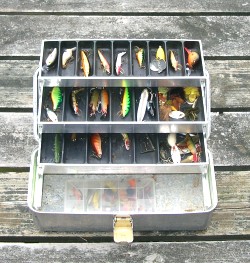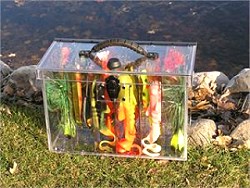Fishing Tackle Boxes For Storage
 When people think of sport fishing, they automatically think of rods, reels, lures, and live bait. Having an organized tackle box is as important fishing tool as you’re rod and reel set-up. Organize all of your lures, baits and terminal tackle in one easy-to-find location will enable you to become a more efficient angler.
When people think of sport fishing, they automatically think of rods, reels, lures, and live bait. Having an organized tackle box is as important fishing tool as you’re rod and reel set-up. Organize all of your lures, baits and terminal tackle in one easy-to-find location will enable you to become a more efficient angler.
Today. tackle boxes and soft bags come in every size and shape imaginable, leaving the beginning angler a vast array of choices in finding one which is right for them.
Starting your tackle box can seem challenging, but if you stick to the basics, you’ll be able to get started with no problems.
In the decision process of which tackle box suits you’re needs, consider the purchase of expensive fishing lures and gear as an investment, which requires proper care and storage to be used for years to come.
We have witnessed the unfortunate experience of anglers lack of maintenance and care of their tackle only to find the condition poor and unusable upon a preparation for a trip or on the water. It only takes a few necessary minutes to ensure proper care and storage.
Follow these storage maintenance quick steps to ensure that your gear will be ready to go again when you are:
Air Out the Tackle Box
Upon return from a fishing trip open the tackle box allowing the lures to dry. Hang the wet inline spinners with hair or hard baits on the side of the box to dry. If you’re caught in rain and have puddles on water in the box remove all tackle, wipe out all water, let the lures dry and replace. Rust on hooks diminishes the strength of the hook and reduces the sharpness, rusty hooks also stains the beautiful paint finish of lures.
Soft Plastics and Biodegradable Baits
With the popularity of fishing with soft plastics and biodegradable baits we recommend for storing use the containers or bags they were sold in, as many of today’s soft baits come with scents impregnated into there bodies.
When using soft baits for trailers ( a soft bait attached to a hook on a inline spinner, spinner bait, dressed jig or a spoon) remove after use. Soft plastics through heat, sun or a chemical reaction have a tendency to melt on the hook affecting the paint of a spoon or the dressing on a spinner or jig. Biodegradable baits if left on will shrink onto the hook the has to be cutoff.
Off Season Tips
It is a wise practice every year before the new fishing season or you’re first trip to re-spool new fishing line and grease the reels. It’s also time to wipe clean and organize the tackle box. Replace any rusty hooks, and split rings on lures, go through and organize the terminal tackle, hooks, sinkers and bobbers. Time to add new lures you heard or read about for the upcoming season as well.
Once you start to enjoy fishing more regularly, you will find out the most productive lures and the one’s that are not. Over time you will build a collection of successful lures learning what methods and presentations work for each species of fish.
Fishing Tackle Box Features
In selecting a tackle box, consider these aspects before buying:
Size
1. The size and function of your tackle box should largely depend on your intended use. Muskie and Northern Pike fisherman will require a larger box to hold lure from 6 inches and up, while panfish anglers require a smaller box to hold terminal tackle and smaller lures.
The other consideration is where you fish; from a boat, or shoreline, weight and mobility should be a factor. A large drawer type or hanging box is best suited for a boat where as the soft sided carry all is best used for shoreline river fisherman or fly-in trips.
Durability
2. After organizing you’re tackle box the last thing you don’t want is the box opening on you spilling your tackle and lures out on the boat, dock or in the water.
A tackle box should be able to handle the wear and tear of fishing and be strong. When buying a new box test the latch, make sure it closes tight. Tackle boxes with metal latches hold better than all plastic.
Water Resistance
3. Most tackle boxes are made of materials that is water resistance. Check to see where the box closes and if water can still in. Any moisture left unchecked can create mold and rust on the hooks. Some of the higher priced tackle boxes come with watertight covers, ventilation and water drainage ports to remove any water that snuck in.
Extra Space
4. Consider having a extra storage area for gear other than lures, leaders and terminal tackle etc. It’s nice to have and you don’t forget the release tools (pliers, jaw spreaders and bolt cutters) as well as head lamps for night fishing, hook sharpener and extra reels or line spools when the need occurs.
Fishing Tackle Box Types
There are numerous kinds of tackle boxes, each having its own special advantages and design features. Here is a description of the most common types of tackle boxes
Trunk-Tray Type Box

The trunk type tray box is the most popular and is usually the first anglers box or received as a gift. This box has a long hinge cover when opened one two or three trays that accordion outward over the lid which lays flat. Dependent on the size the lower half of the trunk-tray box generally is deep enough for extra storage.
Many anglers own several of these types set-up for species specific fishing presentations. Trunk tray boxes are usually smaller, fit well into limited areas and are light weight allowing the angler mobility and quick access to there gear and lures.
Hip-Roof Type Box:

The hip-roof type of box is a modified trunk-tray box, when opened both sides have tackle trays that also accordion outward leaving a large bottom compartment for additional storage. Hip-roofed boxes provides a large amount of organized storage with multiple compartmented trays giving the angler easy access and visibility to their tackle once opened.
Many anglers use the hip-roof tackle box as their home storage and use smaller trunk tray boxes for day trips. However for long trips or if you wish to take along you’re complete tackle selection the hip roof box are great.
Drawer Type Box

Drawer type boxes are a good choice when fishing from a boat, where space is limited, it sits vertically and the drawers slide out. They also are good for wet weather fishing with the exception of opening the drawers everything will stay dry. From organizing your tackle, drawers can be identified by lure type so you know before opening the drawer. Extra storage is a plus on drawer type boxes with a large cover storage or a single bottom drawer, for storing reels, release tools, trolling tools (dodgers, flashers and dipsey divers) hook sharpeners, flashlights etc…
As with all large tackle boxes some anglers prefer to use the drawer type box as their home storage, and have smaller specialty utility boxes for day to day trips.
Satchel Type Box

These briefcase type boxes come in a variety of styles and sizes, from one- to two-sided openers. Satchels are versatile from small lightweight models that carry a dozen of lures or panfish terminal tackle up to larger models that handle dozens of larger lures. The see through sides allow you to identify lures instantly. They make excellent tackle boxes in putting together separate lures and gear for a day on a lake or river trips.
Soft Side Type

Soft side bags are becoming the most popular tackle storage systems in the fishing world today. They are lightweight, waterproof and give the angle total flexibility to hold a variety of plastic utility boxes along with having numerous storage pockets for extra reels fishing tools and a camera. The convenience that soft side bags offer the angler is take only the boxes you need for that day. If you’re crappie fishing no need to take the pike or bass gear. Now you can build component boxes per each species: panfish – bass & pike – trout and muskie and use the soft side bag as the carry-all.
When making a decision to purchase a soft side bag bigger is better. Depending on the dimensions of the bag, utility boxes can number anywhere from two to six or more, while two may work for panfish and crappies, having six to eight will be more versatile for bass, pike and muskies. Make sure the shoulder straps are padded, this helps when carrying to the boat or along the shore. Check to see if the straps and handles have reinforced stitching providing toughness and strength. A sturdy waterproof material is mandatory that resists punctures and tears.
Hanging Type Box:

The hanging box has become popular by Muskie anglers as the box of choice for storing extra large lures. The interior features a set of removable dividers or a grid of square compartments made of colored plastic or clear polycarbonate (Lexan) with slots to hang lures by the rear hook. This makes it easy for easy access, view color selection, eliminates tangled hooks and allows wet lures to dry. The exterior case are available in waterproof plastic, tightly woven padded material or clear uv-resistant
polycarbonate (Lexan).
The design of hanging type box also works well for Great Lakes trolling spoons,Walleye crankbaits, Bass spinnerbaits, and with foam tubes inserts ideal for wrapping crawler harnesses, live bait rigs or snells with storage for bottom bouncers and bait walkers. The hanging box are available from magnum boat boxes, small portable over the shoulder carry on and boat seat slip over pedestal types.

